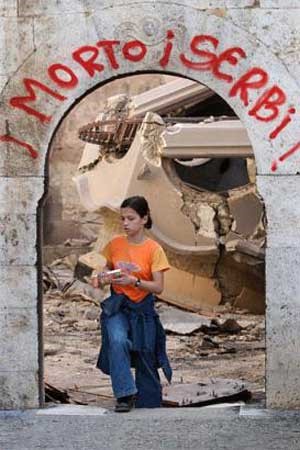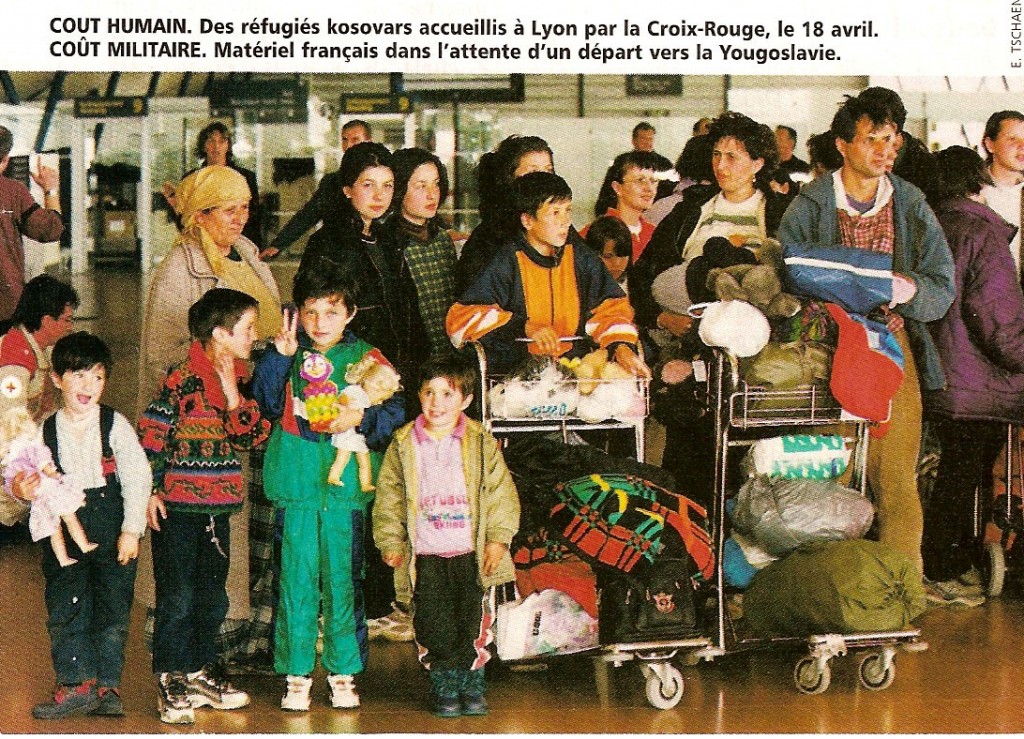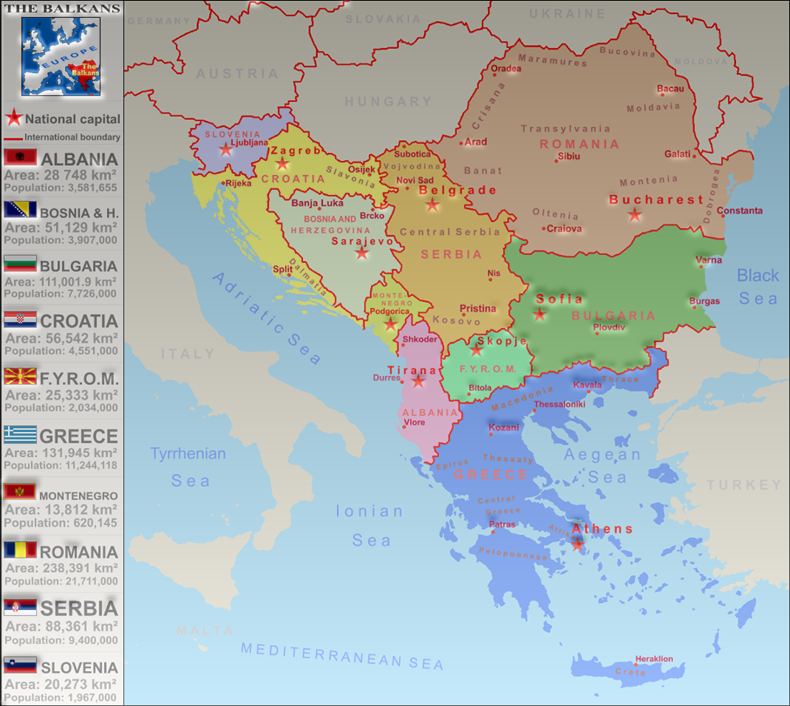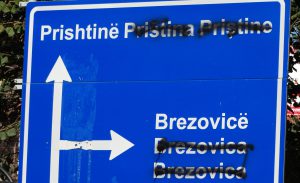
Views: 6633
Figure 1. Ethnic Albanian refugees at the Lion airport, April 18, 1999
A French magazine published a couple of photos from the Lion airport on April 18th, 1999, at the time when NATO bombers were pouring their lethal burden over Serbia (and partly over Montenegro), in the course of their “preventing humanitarian catastrophe” at Kosovo. One picture showed the French weaponry ready to be transported to Kosovo, the other presented an ethnic-Albanian family from Kosovo, refugees just arrived to France. The photo deserves well our attention, for it speaks very much indeed; it exposes vividly the very crux of the matter. Let us analyze this picture, presenting the unfortunate family of Kosovars (as the ethnic Albanians call themselves).
First of all, it is a single family, consisting of three generations. On the left we see grandmother (with scarf), on the right father and mother of the children posing around. Evidently, it is the peasant family. Tough the children appear well dressed (probably by a humanitarian agency), the adults reveal their modest wellbeing. We notice first three daughters, the eldest (somewhat hidden behind the boy in the centre) and two twin girls next to her. Then we see two daughters in the front and two boys beside as well.
The central figure appears the young girl, of about 8, who shows the V sign in a Churchill-like gesture. What is she trying to tell us? The family is hardly in a “victorious position”. Who is going to defeat whom? Who instructed her to pose before the cameras in that manner? These are the questions which come to mind when looking at this scene at the Lion airport. We shall come back to this photo many times later on, but here we need just to bear it in mind.
Kosovo in Serbia
Kosovo is a part of the region on the south-west of Serbia, called Kosovo and Metohia, which was an autonomous region of Serbia from 1945 to 1989, designated by the postwar Serbian state-republic by KosMet, as the short name for Kosovo and Metohia. The very name Kosovo is a short name of Kosovo Polje, meaning in Serb language Field of blackbirds (kðs – blackbird in the Serb language).[1] To avoid confusion we adopt the standard rule for the terms we are going to use here and in the following: Serb(s) will designate the ethnicity and adverb Serb too, like Serb language. Serbians will mean citizens of Serbia (regardless of their ethnicity), and adverb Serbian also, like Serbian state etc. Albanians will designate ethnicity (regardless of their citizenship), and Albanian the adverb, like Albanian language. Ethnic Albanians who are citizens of Serbia will be designated by Shqiptars (Shqiptare, “sons of eagles”),[2] as they call themselves and were called in Yugoslavia until recently. Another interpretation of the term has been as stemming from shqipoj, “one who understands”. This interpretation appears in accordance with similar case of Slav – “one who speaks (slovi)”, as different from Nemac (German), “one who is mute (nem)”. We must mention, however, that most Serbian Albanians consider now the term pejorative, if used by Serbs, for historical reasons.[3] The principal reason is that many designations of the present-day Albanians throughout the history were, to many Balkan people eponymous to wild people, including Turks. In particular, the name Arnaut, widely used during the Turkish occupation of the Balkans, was synonymous to robber, highwayman, belligerent savage etc.[4] The name Shqiptar was in many respect similarly used by Slavic population. Modern equivalent to Shqiptar in our usage, Kosovo ethnic Albanians, is Kosovars, used by Albanians and some foreigners alike. The term appears misleading, however, for it implies “inhabitants of Kosovo”, what includes other ethnicities in the region, at least in Slavic ears. It is with regret that we will have to use this term, nevertheless, for the technical clarity and economy, without any pejorative overtones implied. We just mention that Shqiperia is the internal official name of the present-day Albania. Likewise, Metohia is a corrupt of Greek μετóχι, which designates a dependency of a monastery, usually allotted by the local ruler or the king. The name refers to the monasteries complex of the southwestern part of the region, bordering the Albania, which is crowded by the medieval Serbian monasteries. The same region is called by Albanians Dukagjin, Land of Duke.[5] We mention here that it designates generally a border region, which used to be under the military rule of a duke. The northern Serbian region, which was an autonomous province in the same period as KosMet was (1945−1989) is called Vojvodina (the land of duke), for the same reason, since it was situated between the Habsburg Monarchy (Austria-Hungary from 1867) and the Ottoman Empire for centuries and big part of it was under the military rule as such. (We emphasize here that kos is a purely Serb name, as duka is corrupted Italian one).
It must be stressed here that these details are not merely of linguistic nature, but bear a heavy weight when dealing with the essence of the issue, as we shall elaborate later on. Toponyms appear the most reliable identification of a region and at the same time evidence of the fact as to whom the region belongs. We shall devote some more space to this point here.
We start with Kosovo again.[6] It is a pan-Slavic and pra-Slavic name of the kind of birds, which has about 300 subspecies, from the family Turdidae, derived from the Greek kopsihos. Kosovo field, where a number of important battles were fought, is situated northwest from the regional capital Priština.
Figure 2. Map of the Balkans: Kosovo-Metochia is a central part of it
Topography
Metohia (Metochia) is derived from Greek metohi as mentioned above, from meteho – to take part. It denotes a monastery estate.
Priština, pan-Slavic and pra-Slavic term, derived from prysk, derived in its turn from the Indo-European (s)per, to become the verb prisnoti, meaning to spurt, to gush. In modern Serb prisht designates decease, boil (anthrax). An important trade and mine medieval centre, with a Dubrovnik colony. Serbian King Stefan Dečanski (1321−1331) used to stay at Priština, while Tsar Stephan Dushan (1331−1355) had his court here for some time.[7] After Stephan Dushan Priština became the capital of Vuk Branković feud, and retained that position even after Kosovo battle. His wife Mara lived there with her sons, Grgur (Gregorie) and Đurđe (Georgie), as well as Prince Lazar’s widow Eugenia (Тsarica Milica). Turks took Priština in 1439, but Dubrovnik colony remains there. Priština had its flori in 17th c., as one of the most prominent towns in present-day Serbia. In 1660 a Roman-Catholic missionary mentions it as an important post between Novi Pazar and Constantinople (Carigrad). During Austrian-Turkish war (1683−1699) the former had a small garrison there in 1689.[8] According to their records there were about 360 villages around, some of which were sat to fire by Turks and Tatars and inhabitants slaughtered. At the beginning of 19th century Priština appears an important trade town, with a famous fair, with 12.000 inhabitants. France established her consulate there in 1812. According to some reports, Priština had at the time about 7.000−9.000 inhabitants, mainly Orthodox Serbs, but Arnauts and semi-Islamized Serbs too. In 1852 reports count 12.000−15.000 inhabitants, one third Serbs and Cincars, the rest Arnauts. After two big fires, 1859 and 1863 Priština suffered a considerable decline.
Prizren, pan-Slavic and pra-Slavic name, from zreti, to see. Derived from the Indo-European gher, to flash, participle perfect zren. Prefix pri is the common pan-Slavic and pra-Slavic for besides, at. “Carigrad of Serbian Тsars”, as it used to be called, was mentioned in the Roman time as Teraida. Turks used to call it Terserin and Perserin.. First mentioned as the episcopate in 1019, subordinated to Ohrid archiepiscopate. The first Serbian archiepiscop St Sava (1219−1236) subordinated it to his new Serbian archiepiscopate.[9] Prizren was developed as a trade town in 13th and 14th centuries, especially during King Milutin (1282−1321) and Tsars Stephan Dushan and Stephan Urosh (1355−1371), who had their courts there. Stephan Dushan built a monastery with the memorial church St Archangels (Michael and Gavril). After falling into Turkish hands monastery was demolished and no trace of the grave of Dushan has remained. It was an important colony of Dubrovnik, with two Roman-Catholic churches. Turks took Prizren in 1455. During Turkish occupation Prizren lost most of its trade role. Nevertheless, we have reports of a wealthy Turk Mehmed Hajredin Kukli-beg and his 117 shops (dućans), and 6 watermills and caravanserai. Arnauts appear there late, in the second half of 17th century. only. In 17th century trade receives a new impetus at Prizren, with some 8.600 (1610) and 12.000 (1655) homes. Town was renowned for his fountains, watermills (600), nice houses and pleasant gardens. Craftsmanship was very developed, especially guns and sabers productions. Prizren was the largest Serb town in the region, second only to Skopje. The overwhelming majority of population was Serb Orthodox. Though there was a Roman-Catholic episcope chair, there were 30−40 Roman-Catholic homes only. In both 16th and 17th centuries Prizren was victim of ethnic-Albanian highlanders, mainly Mirdites tribe. Turkish taxes were sometimes extraordinary large and devastating, as a victim complained. At the end of 18th century many towns were devastated by Arnauts, including Prizren, mainly by krdžalije and other highwaymen. Father Sava reports how in 1795 Mahmud-pasha Bushatlija and his Arnauts devastated Prizren that only 7.000−8.000 homes remained, much less than there were in 17th century. In 1805 Pukvilj records that Prizren experienced a revival. Inhabitants were partly Muslims partly Orthodox, but both Serbs, as their (Slavic) language revealed. 19th century witnessed further development of Prizren. According to J. Miller (1844) the following statistics was offered; 6.000 homes, with 18.600 Orthodox citizens, 2.150 Roman-Catholics, 4.000 Muslims (4/5 Serbs), 600 Tsigans (Roma/Gypsis). Trade was mainly in hands of Serbs. Town had many mosques (12 big, 42 altogether), many clock towers, one Orthodox and one Roman-Catholic Church. Trade was done mainly with Thessaloniki, since the trade road to Skadar (Scodra/Scutari) was insecure due to Arnaut highwaymen (kachaks).
Mitrovica, after the Greek saint Demetrios, Serb Dimitrije. Demetrios itself means son of Demetre, goddess of fertility and agriculture.[10] When King Milutin donated (14th century) to the St Stephan monastery at Banjska the church “St Dimitrije under Zvečan”, the new town founded in the vicinity obtained the name D(i)mitrovica, or Mitrovica. Renown Turkish traveler Evlia Čelebija mentions Mitrovica “on the border of Bosnian vilayet”, with the castle (probably Zvečan) abandoned but the town flourishing. Father Jukić mentions (1852) 300 Muslim and 50 Orthodox houses. Unimpressive until 1871 Mitrovica experiences a fast development with railway.
Zvečan was a Serbian castle set up in 11th century during fighting Byzantin Empire. The castle served as a prison (something like London Tower), where many noblemen finished their lifes, including King Stephan Dečanski brother, Constantine, and the King himself. Turkish rule was imposed already at the end of 14th century. Certain “Feriz ćefalija (Z)večanski”[11] arranges an agreement with Dubrovnik in 1399 and the latter donated 50 ducats to him in return. Zvečan used to be left empty for many periods. It suffered the most in 1884 when the wall material was used for building casern and the bridge across Ibar in Mitrovica.
As mentioned before, nearby Banjska was a village, which had a nice monastery, but was ruined after Kosovo battle.[12] But the place won it celebrity after the beautiful folk poem Strahinjić Bane, an epic Serb hero from the place. Turks seems to have founded a small town over the ruins of Banjska, with a mosque and sahat-kula (clock tower). At the hill foot there was a bath,[13] in use long time afterwards. At the beginning of 20th century one could still see a remnant of minaret on the ruins of the old Serb church, converted into mosque in 15th century.
Đakovica, from Greek diakonos, servant, pupil. The earliest record about the place came from 17th century. Original name Gjakova was given by Turks and Arnauts, and Serbs turned it into present-day Đakovica.[14] It was a small town, which started to be populated by Albanians after the Serb migration into Austria (i.e, southern Hungary) in 1689−1690.[15] It was probably on that account that Serbs used to call it Arnaut-Pazar. According to Miller (in 1844 there were 1.900 houses, 11 mosques, 640−650 shops. 18.000 were Muslims, 2.600 Orthodox, 450 Roman-Catholics. As for the ethnical partition the same record provides: 17.000 Arnauts, 3.800 Slavs (Serbs), 180 Turks, and finally some Cincars and Tsigans. However, statistics greatly differ from author to author and may be taken as a rough estimate only. Christians were engaged mainly in craftsmanship, with Roman-Catholics as goldsmiths and Orthodox saddle-makers and painters.
Peć, pan-Slavic and pra-Slavic from pekti, to roast. Pekt-peć means furnace. Cult place of Serbian people, the seat of Patriarchate of Peć, in the nearby church, established under King Milutin (1282−1321). Besides spiritual importance Peć was the town with a lively trade, with Dubrovnik colony. Turks abolished Patriarchate after 1459, to be re-established in 1557 and ultimately abolished 1766 and subordinated to Patriarchate of Constantinople.[16] In 19th c. there was 2.000 houses with 7.000−8.000 inhabitants. Mainly Orthodox (Serbs). Town had 900 shops (dućans). Principal occupation was silk production and agriculture (fruit and tobacco). Despite its size, Peć was not able to develop trade, due to insecurity ”from (local) Arnauts”, who were “public highwaymen”.
Uroševac, pra-Church-Slavic from Uroš, derived from ur, master, from Hungarian ursu for lord. Originally Turkish Ferizović, was a small Gypsy village. The railway made it a town and a trade centre of the region. Albanians called it Ferizaj, and Serbs ultimately named it Uroševac.
Lipljan, old-Serbian, probably from the Roman name for the nearby Roman-Byzantine castrum Ulpiana.
Orahovac, pan-Slavic and pra-Slavic name oreh for nut (orah in the contemporary Serb), derived from Indo-European ar and reks (to smash), something one eats skinned.
Drenica, derived from pan-Slavic and pra-Slavic dren, dogwood, from the Indo-European root dher(e)ghno.
Vučitrn, derived from Serb vuk, pan-Slavic and pra-Slavic vlk, for wolf, Indo-European ulkuos[17] and trn, Teutonic-pra-Slavic term for thorn (Indo-European (s)ter, for thorny plants). Built probably over the ancient Vicianum, is mentioned for the first time in 14th century as a place belonging to Serbian feudal lord Vuk Branković, who had his palace there too. Town was renowned for his trade activities, with Dubrovnik colony. Serbian despot Đurađ Branković (1427−1456) used it as his seat too. In the vicinity there was a well known trade and mine town Trepča. Vučitrn fell to Turks in 1439 (or 1440) for the first time, then definitely in 1455. Some travelers mention it as an important trade centre. Evlija Čelebija counts 2.000 houses, then tekija,[18] schools, Orthodox school (bogoslovija), hamam, vineyards, orchards. In 18th century Vučitrn appears an insignificant place, but becomes the seat of a sandžak (sanjak was Ottoman smaller administrative-territorial unit a part of bigger pashalik). In 1894 one counts about 7.000−8.000 inhabitants. The main occupation was blacksmith and leather craftsmanship.
Glogovac, pan-Slavic and pra-Slavic name from glog for hawthorn (from Greek glohiis – top of blade).
Istok, from tok, pra-Slavic noun for flow (from Indo-European teq – to run (away), and iz as the perfective prefix for the verb teći – to flow, from Indo-European eghs.
Gračanica, pan-Slavic and pra-Slavic diminutive of gord, initially any fenced settlement, later town, and castle, from Indo-European gherdh, to fence.[19]
Kačanik. Turkish name, from kaçak, highwayman. Kachanik was notorious for its highwaymanship from the beginning of known history, which dates from 16th century. Situated at the entrance of the gorge Kačanik, made by the river Lepenac, it controled the passage through the gorge, the only possible between Macedonia and Kosovo. Report from 1573 warns people to guard themselves well in passing the gorge, for the denger from the local Arnauts. It was for this denger that Sinan-pasha built the small fortress at the gorge entrance, which was intended to protect travellers, mainly trademen, from the robbery and slaughter. Austrians under General Piccolomini took the fortress in 1689, but after their retreat in 1690 Turks captured the fortress and slaughered the Ausrian garrison. It was not until 1807, when Reshid-pasha cleared Kačanik from highwaymen that the trafic through the gorge was resumed. Around the middle of 19th century the town consisted of about „hundred miserable Arnaut houses“, situated beside the ruined fortress. Before the Balkan wars (1912−1913) town was renamed by Turks as Orhanije and at that time had about 250 houses.
Serbia proper
Names of rivers, mountains and other geographical entities are likewise Slavic. They are easily recognized by suffixes, like –va for river, -ica for rivers or settlements. We mention rivers Sitnica, Studenica, etc. Suffix -or for mountains is considered to be of Celtic origin, but mountains with this ending are scattered all around the Western Balkan. Some toponyms bear Turkish names, as expected after centuries of the Ottoman rule of this part of the Balkans.[20] We emphasize here that since the KosMet used to be separated from modern Serbia for two centuries, its development was considerably retarded concerning the language and folklore generally. It appears today as a sort of reservation in this respect, as a relict of the ancient times, from the medieval Serbian state and Serb population in general. This is the case with other mountainous regions of the Balkans, in particular Northern Albania, Montenegro and Herzegovina, who were on the margin of European civilization and culture for centuries.[21] We shall come to this point again, later on.
As for the toponyms in Albania, many appear corrupted from the original Greek or Roman, whereas some bear purely Slavic names. This applies particularly to the plane regions, which were settled by ethnic-Albanian montagnars only relatively recently.
 As pointed out above these details are not merely of linguistic nature, but reveal the essence of the issue, as we shall elaborate later on. Unfortunately we have to dwell on the linguistic matters more. It concerns the question of “negative designation”. Ancient Greeks (and Romans as well) used to call other nations “barbarians”, meaning “non-Greeks”, “neither Romans nor Greeks”. It had somewhat pejorative overtones, which one could appreciate regarding their superiority over the surrounding nations, in particular those much less civilized, like Skits.[22] The same point appears with Israelites, who designate non-Jews as goyim, meaning (other, non-Jewish) nations.[23] Though no Jew would admit it, it has a pejorative meaning whatsoever, and this overtone can not be ignored.
As pointed out above these details are not merely of linguistic nature, but reveal the essence of the issue, as we shall elaborate later on. Unfortunately we have to dwell on the linguistic matters more. It concerns the question of “negative designation”. Ancient Greeks (and Romans as well) used to call other nations “barbarians”, meaning “non-Greeks”, “neither Romans nor Greeks”. It had somewhat pejorative overtones, which one could appreciate regarding their superiority over the surrounding nations, in particular those much less civilized, like Skits.[22] The same point appears with Israelites, who designate non-Jews as goyim, meaning (other, non-Jewish) nations.[23] Though no Jew would admit it, it has a pejorative meaning whatsoever, and this overtone can not be ignored.
As we shall see later on, the Albanian issue (question) involves all nationalities in which ethnic Albanians are in close contact at the Balkan Peninsula. Thus one faces the conflict of Albanians versus non-Albanians, which places inevitably ethnic Albanians at a privileged position. This will sounds cynical when we compare civilization levels of both sides in conflict, as we shall see soon. Unfortunately, term “non-Albanians” has been widely accepted by the international community, that even an eventual neologism which would substitute the unfortunate term “non-Albanian” would not do. In a sense this terminology would correspond to “non-sick” man (as compared to sick one), meaning “healthy man”. “Non-Albanian” implies inevitably the feeling of “something wrong” with those singled out so.
Unfortunately, the story does not end here. Serbia used to have, during her recent history, two regions, which had privileged positions relative to the rest of the state. One was the autonomous province of Vojvodina, the other the autonomous region (later to become province, too) of Kosovo and Metohia (KosMet, KosMet). The problem is “rest of Serbia”. Some call it as “Serbia proper”, some “Central Serbia”. The first designation appears particularly unsuitable, for it implies that KosMet is not ”proper Serbia”, thus concealing in the very name a political message.
[1] Amselfeld as Germans call it, after Amsel for blackbird.
[2] Derived from shqipojnë, which designates eagle, possibly totem of a tribe.
[3] We note that Shiptar political leaders at the federal level, used to use this term freely, during Tito’s era.
[4] By contemporary Balkan population Arnauts used to be experienced in a similar sense as North-American Indians by European population in 19-th century.
[5] Another interpretation of this toponym from Albanian side is that it was the land of the medieval family Dukagjini, but the latter, if ever existed, comprised much larger area than Metohia.
[6] In this paragraph we are making use of the linguistic elaboration by Vladan Đorđević, published in the daily “Politika”, and geographical study by K. N. Kostić, Our New Towns on the South (Naši Novi Gradovi na Jugu, Beograd: Srpska književna zadruga, 1922).
[7] About the Empire of Stephan Dushan see: Миладин Стевановић, Душаново Царство, Београд: Књига-Комерц, 2001.
[8] About this war and KosMet see: Радован Самарџић и други, Косово и Метохија у српској историји, Београд: Српска књижевна задруга, 1989, 127−141.
[9] About St Sava see: Драган Антић, Љиљана Цвекић, Венац Светога Саве, Шабац: Глас цркве, 1988.
[10] According to Robert Graves, Demetre means mother of barley.
[11] It was probably after him that town of Ferizović (later Uroševac) got his name.
[12] As we shall see, Slobodan Milošević’s family claims to have the origin from Banjska.
[13] Banja in Serb means bath, spa.
[14] Other variants are known, like Jakova, or Giacovo.
[15] About this First Great Serbian Migration see: Стефан Чакић, Велика сеоба Срба 1689/90 и патријарх Арсеније III Црнојевић, Нови Сад: Добра вест, 1990.
[16] About historical role of the Patriarchate in preservation of Serbian national and cultural identity see: Vladislav B. Sotirović, “The Historical Role of the Patriarchate of Peć in Preservation of Serbian National and Cultural Identity”, Актуальнье проблемы науки в контексте православных традиций, Сборник материалов международной научно-практической конференции, 28−29 февраля 2008 года, Армавир, Россия, 2008, 22−25.
[17] Ulk has been preserved in contemporary Albanian, as a common name, with the same meaning – wolf. In modern Serb Vuk appears a common name, too, in particular among Dinaroids.
[18] Dervish house, after Turkish tekke (Arab täkyä).
[19] Some toponyms Shiptars still call by Albanian names, like Ferizaj for Uroševac.
[20] About Ottoman rule in the region see: Peter F. Sugar, Southeastern Europe under Ottoman Rule, 1354−1804, Seattle−London: University of Washington Press, 1977.
[21] See the book by Maria Todorova, Imagining the Balkans, New York−Oxford: Oxford University Press.
[22] The anecdote on dispute between a bully Greek and philosopher Abaris, of Scythian origin, who exclaimed “My homeland is shame for me, but you are the shame of your homeland!” illustrates well the issue.
[23] In modern parlance it renders gentiles.
Compiled by White Nettle
Origins of images: Facebook, Twitter, Wikimedia, Wikipedia, Flickr, Google, Imageinjection, Public Domain & Pinterest.
Read our Disclaimer/Legal Statement!
Donate to Support Us
We would like to ask you to consider a small donation to help our team keep working. We accept no advertising and rely only on you, our readers, to keep us digging the truth on history, global politics and international relations.
FOLLOW US ON OUR SOCIAL PLATFORMS











